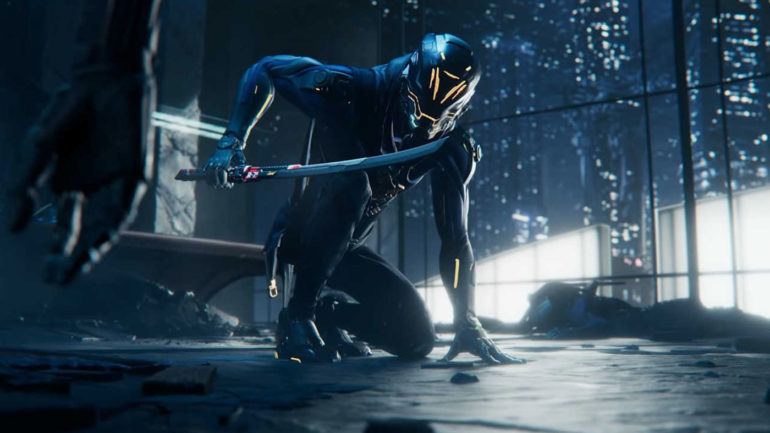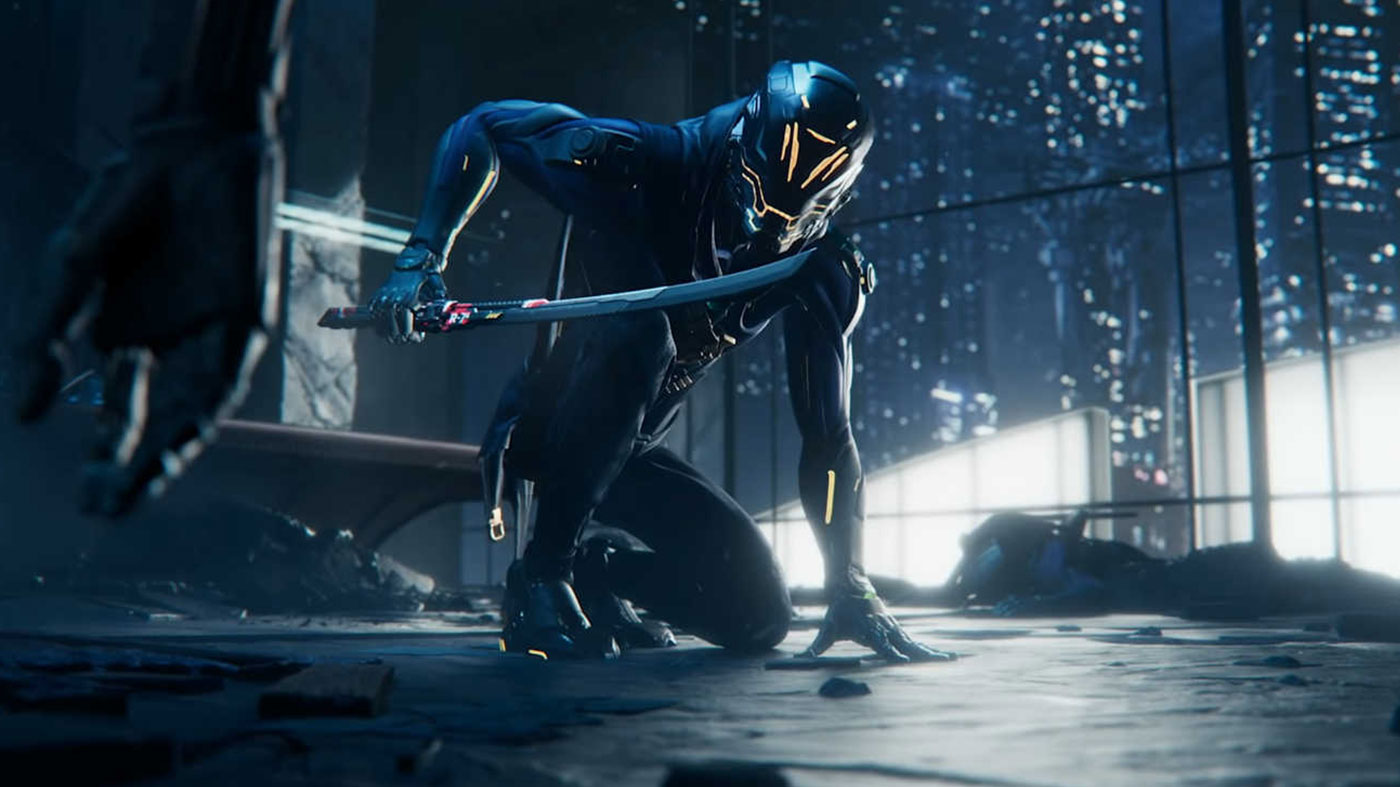You’d be forgiven for thinking there’s just one cyberpunk-set action game being developed by a Polish studio this year, the conversation has certainly been dominated. But One More Level’s unique take on an all-too-bleak future, shattered by cataclysmic change, is as exciting as anything I’ve played this year. It’s a frenetic first-person slasher that, while imperfect in ways, is aided by a clever, quick respawn feature that never puts the revolution on pause.
Dharma City, a city situated within a giant tower megastructure, is the scene of humanity’s last stand and yet, through implants, much of that humanity is long gone and has been instead replaced by uprising and violence. Rebuilt and awoken by the Climbers, an activist group set on upending the status quo, you’re the titular Ghostrunner, the singular hope to cut the tyrannical head off of the snake and return power to the people. It’s on-point in its themes and delivers on a believable, realised cyberpunk world. There was a point where I reached a new level of the tower and I thought I could see the clouds, only for the projection to flicker and fail—a kick in the guts reminder that this is a desperate world on the brink of collapse.

Much of the game’s narrative unfolds through narrative dump walk and talks within the Cybervoid, an interconnected network inside which you rediscover forgotten, dormant skills that help you become a lethal weapon the higher you ascend toward the endgame. It’s here you first meet ‘The Architect’ who sets you on the path to overthrow the Keymaster, a once-dear friend who betrayed you both to annex the last city. These sections, while offering some neat logic puzzles, exist to serve the story rather than the game itself and feel like the lowlight of the experience. The story itself feels rather cliche, predictable, and it leans especially hard on the ‘chosen saviour’ arc. That said, it’s still a fascinating setting that does plenty in setting itself apart from other cyberpunk-set art to the point where I could easily see a graphic novel or an animated series coming from this.
The beauty of the Ghostrunner experience is that it’s two-pronged. Of course, it offers freerunning which is a real joy when it works as intended, though the game also boasts a tight, fast-paced arena-style of combat where everything is a one-hit kill. Although this is equal parts frustrating and gratifying, as all challenges should be, the game is superbly designed and never removes the player from the coalface. You’ll be well-acquainted with death by the end of Ghostrunner, though you’ll spend next to no time at all stuck in loading screens or menus. This quick turnaround does a lot to encourage troubleshooting, which is great because although the game drops you into these self-contained fights it never tells you how to best get the job done—instead, it gives you options, tools and just sends you out.
Outside of abilities, the katana is your singular offensive tool and it’s certainly brutal. It’s up close and it’s personal, and it feels like an homage to what Dishonored did with its swordplay, though this manages to feel more rounded and focused, but that’s expected when it’s the core combat focus. Although you’re going to die plenty, Ghostrunner makes you feel superhuman when you’re blinking midair, deflecting bullets with your katana, and defying odds against what feels like an army at times.

The game’s map design is a triumph on its own. Each and every playspace, both nonlinear and linear, feel as though they’ve been playtested to the point of near perfection. During some of the longer running sections, a few flaws do become exposed. A slightly-off angle of entry or even too much speed can see you clipping wall edges and spoiling long chains of unfettered running through the fault of too much momentum, which feels like something the game should reward. It doesn’t help that there are a couple of particular platforming moments in Ghostrunner that are punishing and demand long chains of flawless traversal. You won’t come across a scenario in Ghostrunner’s twelve-hour campaign that isn’t unique as the world, as well as the security detail and bandits that roam it, evolve to cater to each new ability and trick you unlock. From start to finish, the game throws new enemy variants at you, each with their own particular strategies and kinks.
Once unlocked, each of the Cybervoid abilities has various tiers of buffs you’re able to apply to them. I feel as though Ghostrunner handles its upgrade tree in a really great way which, again, is conducive to player freedom and experimentation. Each of the abilities’ buffs is broken down into polyominoes which can be placed into a finite grid—kind of like Tetris. It’s impossible to fit them all but the changes aren’t permanent, so being able to freely chop and change upgrades to suit any given scenario is one of the game’s real strengths. One late-game ability does present an opportunity to cheese tougher fights, but other than that, they’re all wonderful and suited to this ‘enhanced’ world.
Ghostrunner’s Dharma City really feels like a playground for the player with its forking paths making it a worthwhile endeavour to venture from the beaten path. There are plenty of secrets hidden throughout the trash-clad balconies of the city, from small caches of lore through artefacts left behind before the collapse to new skins for Ghostrunner’s katana, each one more beautiful than the last. The game is already a rich source of replay value because of the inherent, rapid speedrun nature associated with it but combing the city for all of the collectibles is certainly something I can see myself doing.

As challenging and fun as it is, Ghostrunner is also an exceptionally beautiful game. For a game with such a focus on pace, sudden turning, and rather intense delimbification, Ghostrunner holds its framerate together exceptionally well whilst maintaining its gorgeous dystopian aesthetic. The game blends high-tech futurism with a sense of an oppressed lower class, and the game universe’s transhumanist marriage of biology and technology leads to a lot of disturbing body horror that I’ve not seen since the gene-splicing in BioShock—it’s a stunning depiction of cyberpunk gore that runs as smooth as a bullet train. The build we’re reviewing has an option for ray tracing—I believe the final build is being treated as experimental for now—and it looks divine, sacrificing nearly nothing of the game’s other visual flourishes to deliver gorgeous, real-to-life lighting.
The game’s tremendous presentation is rounded out by a bone-crushing dark synth score from Daniel Deluxe. It’s an excellent composition that perfectly encapsulates the gritty chaos of Ghostrunner’s world with fully-loaded synths, pounding percussion, and bass drops that’ll make your guts dance. I sense that Daniel Deluxe has an innate appreciation for the source material given he has composed a score so intrinsically woven into the game—which isn’t something I’ve heard since Mick Gordon reinvented the Doom soundtrack.
Ghostrunner is a fast, pulsating, and challenging action-slasher that does so much right while only fumbling a little. It has a clever design that never puts the action on pause while its several paths, abilities, and tactics offer a near-endless source of experimentation for the player.




